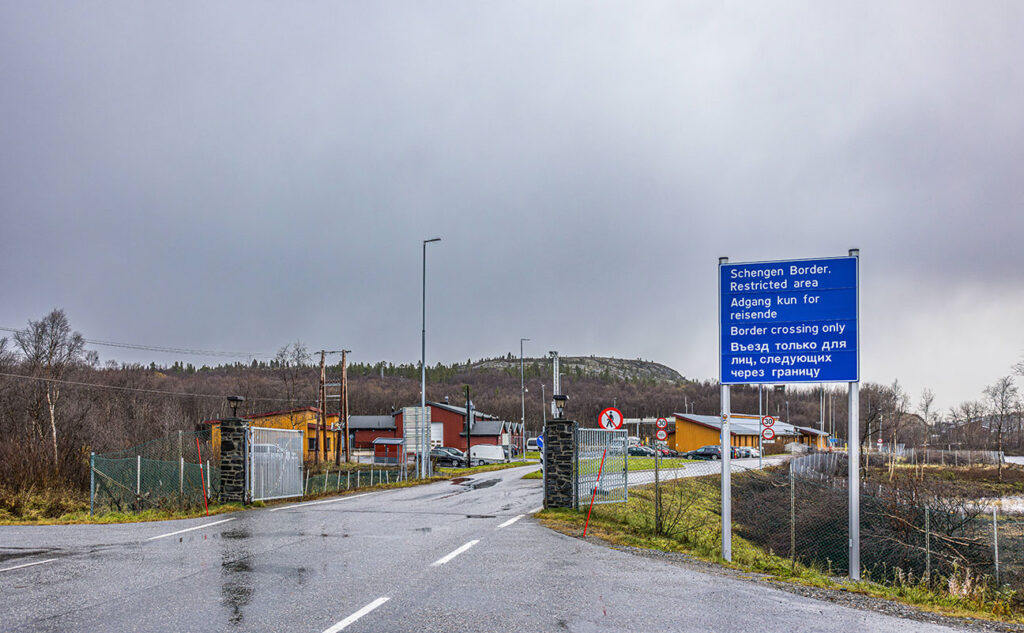The Norwegian-Russian border at Kirkenes, Norway, about 13 kilometers from Storskog, on October 16, 2023. REUTERS
Following the example of its neighbor Finland, Norway put up fences at exposed sections of its border with Russia in May 2025, bolstering security at the Storskog border checkpoint. The action came a year after Norway closed its border with Russia.
Authorities said they want to be more prepared in case Russia sends a wave of migrants toward Norway, as it did in 2015. That year, about 5,500 people from north Africa, the Middle East and Central Asia were flown north from Moscow to Murmansk and then traveled to the Storskog border, crossing unimpeded in what was once a strictly controlled zone. Many traveled by bicycle to circumvent regulations prohibiting foot or vehicle crossings. In May 2024, Norway canceled Russian tourist visas and closed the border with Russia, except in special circumstances.
“A border fence is very interesting, not only because it can act as a deterrent but also because it contains sensors and technology that allow you to detect if people are moving close to the border,” Norway’s justice minister, Emilie Enger Mehl, told Norwegian public broadcaster NRK in September 2024. “It’s a measure that may become relevant on all or part of the border” with Russia, she said.
Finland faced its own border chaos in December 2023, when thousands of migrants in Russia rushed to the border to cross before Finland reinstated border controls. Finland has said the exodus was deliberately orchestrated by Moscow and that Russia’s Federal Security Service, commonly known as the FSB, let almost 100 migrants through without valid documents.
Finland began building a fence on the Russian border last year in response to the migration. The Finnish Border Guard says it is designed to stop migrants from crossing via the wilderness. In May 2025, Finland said it had completed the first 35 kilometers of the fence, which is 4.5 meters high. Eventually, the fence will cover 200 kilometers of the border’s total length of 1,344 kilometers, Finland says.
The Storskog-Borisoglebsk road in Norway is now the only open land border between the Nordic countries and Russia, but it maintains strict immigration restrictions. The fence will help prevent people from avoiding the checkpoint and traversing nearby unguarded lands to get into Norway.
Norway shares a 198-kilometer border with Russia, to the east. About two-thirds of the border follows two rivers, so no fences can be installed there. On the Russian side, a barbed wire fence stretches from the Barents Sea in the north to the Baltic Sea in the south, establishing a border zone where civilians have no access.
There only have been a few illegal border crossings in Norway since Russian President Vladimir Putin ordered the invasion of Ukraine in 2022. Andrei Medvedev, a former soldier for the Russian military company Wagner Group, ran across the ice-covered Pasvik River into Norway and sought asylum in January 2023. In two other cases, people made it into the country over land near Storskog.
Since the Russia-Ukraine war began in 2022, Nordic governments have been boosting defense spending, reassessing security and pushing the concept of total defense, which mobilizes all of society to defend against military and nonmilitary threats.
In testimony before the Senate Armed Services Committee on February 13, 2025, Gen. Gregory M. Guillot, commander of U.S. Northern Command and the North American Aerospace Defense Command, said: “As Russia’s brutal and misguided invasion of Ukraine enters its fourth year, there remain several plausible pathways by which the war could escalate into a direct military conflict with the United States.”

